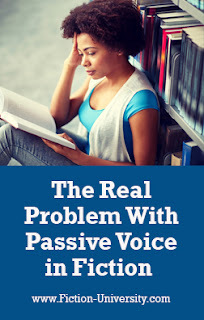Janice Hardy's Blog, page 10
May 23, 2023
Grow Up Already: Creating Character Arcs
 By Janice Hardy, @Janice_Hardy
By Janice Hardy, @Janice_HardyA strong character arc will weave its way through the turning points of the plot.
A character arc is the internal struggle and progress a character goes through over the course of a novel that changes them in some way. It's usually connected to the internal conflict so that what they do (the plot) forces changes in who they are (the character arc). It can sometimes be confused with character motivations (a character worries over something so they act to prevent that something) but why a character acts is different from how they change because of their actions. Motivation drives the actions. Growth is the result of the actions.
But should the writer know where the character is heading/motives before the first draft? Is it bad if you don���t?"Heck no.
Continue ReadingWritten by Janice Hardy. Fiction-University.comMay 15, 2023
Internal Medicine: How Much Internalization is Too Much?
 By Janice Hardy, @Janice_Hardy
By Janice Hardy, @Janice_HardyReaders want to know what's going on in a character's head, but they don't need to know every last thought.
Internalization is the glue that holds a story together. It's where the readers learn why those awesome descriptions matter, who those great characters we create really are, and shows why those cool conflicts hurt so badly.
But good internalization requires a balance. Too much and the character in too in their head and slows the story, too little and the reader can't connect to the character enough to care about the story.
If you’re unfamiliar with the term, internalization is what's going on in your point of view (POV) character's head. It's how they see the world and how they choose to tell the reader about it. It's the filtering process that makes everything in the story have meaning, and conveys the opinions and judgment of the POV character.Continue ReadingWritten by Janice Hardy. Fiction-University.com
May 11, 2023
Getting Your Short Story Published: What You Need to Know About Submission, Rights and Payments
 By Rayne Hall, @RayneHall
By Rayne Hall, @RayneHallPart of the Focus on Short Fiction Series
JH: Writers are on their own when it comes to the business side of short stories. Rayne Hall explains what you need to know when submitting and publishing your short fiction.
We’re in a ‘golden age’ for short stories, with more opportunities for short story authors than ever before. This doesn’t mean that getting your tales published is easy, or a way to earn riches fast.
You need to be sure that your stories are good, and you need to submit them to the right markets.
Where To Submit Your Story
If your story falls under a category (a ‘genre’), focus on markets specializing in that genre, because there your chances of acceptance are greatest.
Continue ReadingWritten by Janice Hardy. Fiction-University.com
May 8, 2023
The Power of Small Problems: Elevate Your Plot with Little Conflicts
 By Janice Hardy, @Janice_Hardy
By Janice Hardy, @Janice_Hardy Little problems can be just as devastating to your characters' plans as full-blown issues.
I'm prone to migraines and when one hits, I'm pretty much down for the day (or longer if it's bad). As you can imagine, that puts a bit of a crimp in my day. It's hard to get much writing done when you can't stare at a screen without pain. Annoying little issues are things we deal with every day, so why not make sure our characters also have to deal with them?
When you're creating your characters and their lives, don't forget to add in the little things that can cause them trouble, even if it's not earth-shattering trouble.
Think about the bad days you've had, where nothing went right, and how that escalated into you snapping and yelling at someone who didn't deserve it. Or caused you to do something you wouldn't have ordinarily done had you not already been stressed by stupid little things.
In other words, pile on the problems.
Continue ReadingWritten by Janice Hardy. Fiction-University.com
April 24, 2023
The Difference Between a Writing Problem, and a ���Not for Me��� Issue
 By Janice Hardy, @Janice_Hardy
By Janice Hardy, @Janice_Hardy Sometimes the problem is with the reviewer, not the book.
Not every book is for every reader. Readers have topics they dislike no matter how well written a book is, and nothing you do is going to change that. Sometimes, the problem with a book isn't the quality���it's just a "not for me" issue.��
This is an important distinction in writing. I���ve read many a novel that was a ���good novel,��� even if it did things I don���t particularly care for as a reader. I didn���t like it, but I could see that others would.��
For example, I���m not fond of distant narrators. It���s nearly impossible for me to connect with a distance third-person omniscient narrator, because I never feel like I���m in the protagonist���s head. I just can���t lose myself in the story.Continue ReadingWritten by Janice Hardy. Fiction-University.com
The Difference Between a Writing Problem, and a “Not for Me” Issue
 By Janice Hardy, @Janice_Hardy
By Janice Hardy, @Janice_Hardy Sometimes the problem is with the reviewer, not the book.
Not every book is for every reader. Readers have topics they dislike no matter how well written a book is, and nothing you do is going to change that. Sometimes, the problem with a book isn't the quality—it's just a "not for me" issue.
This is an important distinction in writing. I’ve read many a novel that was a “good novel,” even if it did things I don’t particularly care for as a reader. I didn’t like it, but I could see that others would.
For example, I’m not fond of distant narrators. It’s nearly impossible for me to connect with a distance third-person omniscient narrator, because I never feel like I’m in the protagonist’s head. I just can’t lose myself in the story.Continue ReadingWritten by Janice Hardy. Fiction-University.com
April 17, 2023
Living in My Head: Crafting Natural-Sounding Internal Thoughts
 By Janice Hardy, @Janice_Hardy
By Janice Hardy, @Janice_Hardy How to write tight, third-person internalization that feels natural to the character.
Getting inside a character's head is a key element to getting the reader to care about that character—love them, hate them, fear them, whatever the emotion you want to evoke.
In first person this is easy, because you're already so close to their perspective the thoughts roll naturally into the story. With third person it can be more challenging, because there's an extra layer between the character and the reader. The narrative distance often determines how your internalization will sound.
A close narrative distance will make the internalization feel similar to first person (without the "I" of course). A more distant one will include tags such as he thought. Some will use italics, others will make it part of the narrative. The style is up to you.
((Here's more with Where Do You Want Me? Choosing Narrative Distance in Multiple Third Person).)
Continue ReadingWritten by Janice Hardy. Fiction-University.com
April 13, 2023
Give Your Story Meaning with Inner Conflict and Theme
 By Rayne Hall, @RayneHall
By Rayne Hall, @RayneHallPart of the Focus on Short Fiction Series
JH: No matter the size of your story, a theme can deepen it and make it stronger. Rayne Hall shares tips on finding and developing your story’s theme.
Do you want your story to be meaningful and memorable? Then give it a theme.
Although there are many ways of creating and exploring a theme, here's the one I find the easiest as well as the most powerful.
'One Purpose/Ideal/Value' versus 'Another Purpose/Ideal/Value'.
For example:
Love versus SafetyPatriotism versus FriendshipFaith versus IntegrityHonesty versus CompassionContinue ReadingWritten by Janice Hardy. Fiction-University.com
April 10, 2023
The Real Problem With Passive Voice in Fiction
 By Janice Hardy, @Janice_Hardy
By Janice Hardy, @Janice_HardyPassive voice in a novel can put your readers right to sleep.
Before we dive in, a little heads up that I'm over at Writers in the Storm today, chatting about how to use clichés, metaphors, and similes to bring your story world to life. Come on over and say hello.
And now on to our regularly scheduled article...
“Avoid the passive voice” is one of those pieces of advice most writers have heard and likely struggled with at some point. It’s good advice, since revising passive into active typically makes the sentence stronger, but like all things writing, simply doing it because people say so isn’t always the best idea.
Without understanding why a passive voice causes trouble, you might rewrite it when its actually the best thing for your story at that moment. It does have it’s uses after all.
So first, let's look at what passive voice means.
I used to be one of those folks who wrongly equated passive voice with all forms of the "to be" verb, and I'm guessing I'm not the only one. Because quite often, a “to be” verb is at the heart of a troublesome sentence, but a “to be” verb doesn't always signal passive writing.
April 3, 2023
3 Steps to Crafting a Story Arc that Sucks
 By Janice Hardy, @Janice_Hardy
By Janice Hardy, @Janice_Hardy Sucks readers in…of course.
A novel is a series of smaller story arcs all leading toward “an exciting conclusion,” whatever that may be. These smaller arcs fit together like puzzle pieces and make up the larger plot and story of the novel.
At its most basic, a story arc is the trajectory that a story takes from its beginning to its end. But a well-crafted story arc is much more than that. It's the engine that drives a story forward, the structure that gives it shape, and the journey that takes readers on an emotional roller coaster.
Let's explore the three essential components of a story arc: the beginning, the rising action, and the climax.
Continue ReadingWritten by Janice Hardy. Fiction-University.com



